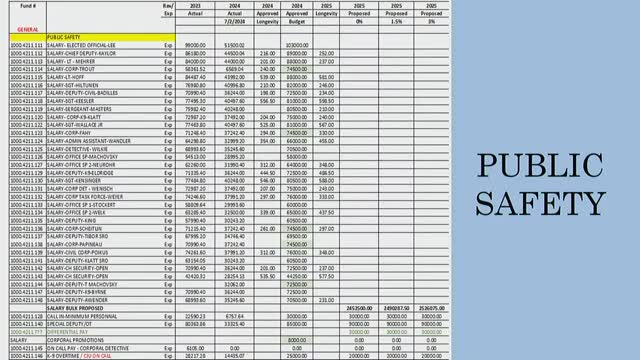Police Department Budget Proposal Sparks Controversy Over Overtime
September 17, 2024 | Stark County, North Dakota
This article was created by AI summarizing key points discussed. AI makes mistakes, so for full details and context, please refer to the video of the full meeting. Please report any errors so we can fix them. Report an error »

During a recent government meeting, key discussions centered around budget allocations for the upcoming fiscal year, particularly focusing on salary adjustments, overtime expenses, and operational costs for the police department.
The meeting began with a debate on the distribution of a proposed 1.5% cost of living adjustment (COLA) for department employees. It was clarified that this increase would be automatically granted, while an additional 1.5% would be allocated for merit-based evaluations. The department head emphasized the need for clarity on how these adjustments would be implemented.
A significant point of discussion was the introduction of differential pay for overnight shifts, which would provide an additional $2 per hour for employees working after 6 PM. This initiative aims to incentivize night shift work, a practice already adopted by several local police departments. The budget for this differential pay is set at $30,000.
Overtime expenses were also a focal point, with the budget increasing from $85,000 to $90,000. This rise reflects the department's expanded responsibilities, particularly during election years and community events. However, the canine division will see a reduction, with one dog being retired in 2025 without plans for immediate replacement.
Other budgetary considerations included an increase in funding for school programs from $7,000 to $10,000 and a request for additional resources for medical exams related to law enforcement training. Vehicle expenses are projected to rise significantly, with a proposed budget of $185,000, although officials expressed uncertainty about whether this would be sufficient.
The meeting also touched on the costs associated with maintaining the shooting range, including ammunition and equipment improvements. The department is currently managing existing resources without investing in new equipment, pending potential future developments in facility upgrades.
Overall, the discussions highlighted the department's commitment to maintaining operational efficiency while addressing the needs of its personnel and the community. The proposed budget adjustments reflect a strategic approach to managing resources effectively in light of evolving demands on law enforcement services.
The meeting began with a debate on the distribution of a proposed 1.5% cost of living adjustment (COLA) for department employees. It was clarified that this increase would be automatically granted, while an additional 1.5% would be allocated for merit-based evaluations. The department head emphasized the need for clarity on how these adjustments would be implemented.
A significant point of discussion was the introduction of differential pay for overnight shifts, which would provide an additional $2 per hour for employees working after 6 PM. This initiative aims to incentivize night shift work, a practice already adopted by several local police departments. The budget for this differential pay is set at $30,000.
Overtime expenses were also a focal point, with the budget increasing from $85,000 to $90,000. This rise reflects the department's expanded responsibilities, particularly during election years and community events. However, the canine division will see a reduction, with one dog being retired in 2025 without plans for immediate replacement.
Other budgetary considerations included an increase in funding for school programs from $7,000 to $10,000 and a request for additional resources for medical exams related to law enforcement training. Vehicle expenses are projected to rise significantly, with a proposed budget of $185,000, although officials expressed uncertainty about whether this would be sufficient.
The meeting also touched on the costs associated with maintaining the shooting range, including ammunition and equipment improvements. The department is currently managing existing resources without investing in new equipment, pending potential future developments in facility upgrades.
Overall, the discussions highlighted the department's commitment to maintaining operational efficiency while addressing the needs of its personnel and the community. The proposed budget adjustments reflect a strategic approach to managing resources effectively in light of evolving demands on law enforcement services.
View full meeting
This article is based on a recent meeting—watch the full video and explore the complete transcript for deeper insights into the discussion.
View full meeting
